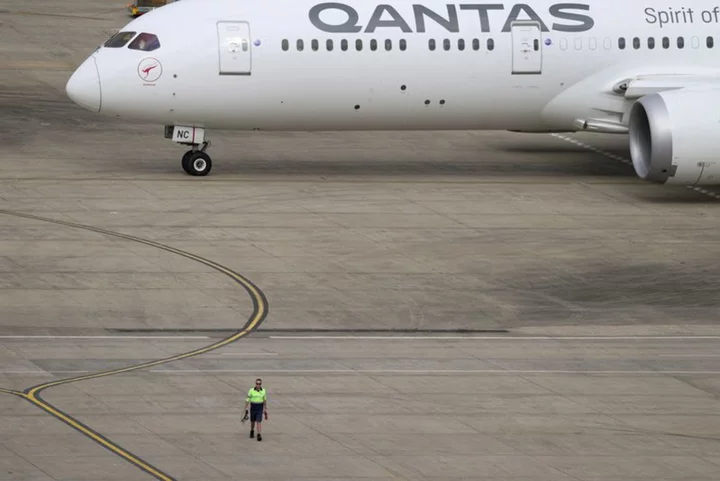
Ant Consumer Finance Arm to Raise $616 Million to Revive Growth
Ant Group Co.’s consumer finance affiliate is raising 4.5 billion yuan ($616 million) from investors, as the Jack
1970-01-01 08:00

'I rejected it, like, full on': Kevin Bacon was scorched by Footloose fame
Kevin Bacon "rejected" the fame that he got from starring in 'Footloose' as he had his heart set on becoming a "serious actor".
1970-01-01 08:00

The Mississippi River is starving for rain. Its prospects are grim
Water levels on the Mississippi River are nearing historic lows for the second consecutive year, triggering a drinking water emergency in Louisiana as ocean water flows upstream, unimpeded by the river's uncharacteristically weak flow. With no substantial rain in the immediate forecast, levels are expected to drop to even more dire levels in the coming weeks.
1970-01-01 08:00

Smokers 2.6 times more likely to give birth prematurely
Women who smoke during pregnancy are 2.6 times more likely to give birth prematurely compared with non-smokers – more than double the previous estimate, new research suggests. The University of Cambridge study also found smoking meant the baby was four times more likely to be small for its gestational age, putting it at risk of potentially serious complications including breathing difficulties and infections. There was no evidence caffeine intake was linked to negative outcomes. We’ve known for a long time that smoking during pregnancy is not good for the baby, but our study shows that it’s potentially much worse than previously thought Professor Gordon Smith, University of Cambridge Professor Gordon Smith, head of the department of obstetrics and gynaecology at the University of Cambridge, said: “We’ve known for a long time that smoking during pregnancy is not good for the baby, but our study shows that it’s potentially much worse than previously thought. “It puts the baby at risk of potentially serious complications from growing too slowly in the womb or from being born too soon. “We hope this knowledge will help encourage pregnant mums and women planning pregnancy to access smoking-cessation services. “Pregnancy is a key time when women quit and if they can remain tobacco free after the birth there are lifelong benefits for them and their child.” The NHS recommends that women who are pregnant should stop smoking and limit their caffeine intake because of the risk of complications to the baby. When the toxins from smoke travel through the bloodstream to the baby, it struggles for oxygen. When this happens it affects their development, and is linked to premature birth and low birthweight, though it has also been linked to a reduced risk of pre-eclampsia (high blood pressure during pregnancy). High caffeine intake has also been linked to lower birthweight and possibly foetal growth restriction. But caffeine can be more difficult to avoid than cigarette smoke as, as well as being found in coffee and tea, it can be found in chocolate, energy drinks, soft drinks and certain medications. Researchers say studies looking at the links between smoking and caffeine and their impact on pregnancy tend to rely on people reporting how much they have consumed, or exposure to smoke, data which is not always reliable. Blood tests for metabolites – chemical by-products created when substances such as tobacco and caffeine are processed in the body – might be more accurate. Researchers at Cambridge and the Rosie Hospital, part of Cambridge University Hospitals NHS Foundation Trust, recruited more than 4,200 women who attended the hospital between 2008 and 2012 as part of the Pregnancy Outcome Prediction (POP) study. The team analysed blood samples taken from a group of these women four times during their pregnancies. To assess exposure to cigarette smoke, the team looked at levels of cotinine, which can be detected in blood, urine and saliva. Only two out of three women with detectable levels of cotinine in every blood sample were self-reported smokers, showing that this measure is a more objective way of assessing smoking behaviour, researchers say. A total of 914 women were included in the smoking analysis. Of these, 78.6% were classified as having no exposure to smoking while pregnant, 11.7% as having some exposure and 9.7% as having consistent exposure. The study, published in the International Journal of Epidemiology, found that compared with those without smoke exposure while pregnant, those with consistent exposure were 2.6 times more likely to experience spontaneous preterm birth. According to the researchers, this is more than double the previous estimate of 1.27 from an analysis of multiple studies. They were also 4.1 times as likely to experience foetal growth restriction. Additionally, babies born to smokers were found to be on average 387g lighter than babies born to non-smokers – that is, more than 10% smaller than the weight of an average newborn. This increases the risk that the baby will have a low birth weight (2.5kg or less), which in turn is linked to an increased risk of developmental problems as well as poorer health in later life. Unlike in previous studies, the team found no evidence that smoking reduced the risk of pre-eclampsia. To assess caffeine intake, researchers looked for the metabolite paraxanthine in 915 women. Of these women, 12.8% had low levels of paraxanthine throughout pregnancy (suggesting low caffeine intake), 74.0% had moderate levels and 13.2% had high levels. The researchers say there was little evidence of an association between caffeine intake and any of the negative outcomes. However, because the researchers did not study all possible adverse outcomes of pregnancy, and some of the outcomes not studied – such as stillbirth – have been associated with higher caffeine intake in previous studies, they cannot interpret the findings as indicating that current recommendations around caffeine intake should be changed. The work was supported by the National Institute for Health and Care Research (NIHR), Cambridge Biomedical Research Centre and the Medical Research Council. Read More Charity boss speaks out over ‘traumatic’ encounter with royal aide Ukraine war’s heaviest fight rages in east - follow live Female students ‘more than twice as likely’ to be affected by poor mental health, research shows Many parents of under 5s on less than £50k ‘quit work due to childcare costs’ – survey 5 trainer trends that will be everywhere this autumn
1970-01-01 08:00

Female students ‘more than twice as likely’ to be affected by poor mental health, research shows
Female university students are more than twice as likely as male students to say they have been affected by poor mental health, new analysis suggests. Data shows 12% of female students say they have been affected, compared to 5% of males. Reported mental health problems among university students have almost tripled in recent years, according to the analysis. The percentage of undergraduate students at universities across the UK who said they had experienced mental health difficulties rose from 6% to 16% between the 2016/17 and 2022/23 academic years. It means one in six undergraduates now reports experiencing mental health challenges. The findings suggest further action should be taken to prevent mental health difficulties arising wherever possible, and that services are adequately resourced to support students quickly when they need help Professor Michael Sanders, King’s College London Analysis by the Policy Institute at King’s College London and the Centre for Transforming Access and Student Outcomes in Higher Education (TASO) found a significant part of this increase occurred in the last 12 months, a period during which the cost-of-living crisis intensified. Poor mental health is by far the most common reason for students wanting to drop out of university. Among those considering dropping out, the proportion citing financial distress as the main reason has risen from 3.5% to 8% between 2022 and 2023. But the general upward trend in mental health problems predates both the rise in inflation and the Covid-19 pandemic, indicating that other factors are likely to be at play, researchers said. The analysis – which drew on a dataset of 82,682 full-time UK undergraduates over seven years – shows some groups are more affected than others. Of the non-binary respondents, 42% said they have been affected by poor mental health, along with 30% of trans people. Bisexual people (28%) have the highest average levels of mental health difficulties among LGBTQ groups across the data, while gay men (14%) have the lowest – although this is still greater than the level seen among straight people (7%). White students (12%) have on average worse mental health than their peers from other ethnicities, but those with a “mixed” ethnicity (12%) are just as likely to have mental health difficulties. Undergraduates who attended state schools (15%) have on average worse mental health than their peers who attended private school (11%), while students who get most of their money through a maintenance loan, grant or paid work are more likely to have mental health difficulties than those on scholarships or with family support. Michael Sanders, professor of public policy at the Policy Institute and author of the study, said: “It’s clear the experiences of mental ill-health among students are deeply unequal, and exist along much the same lines as in society at large, with those from the most disadvantaged backgrounds or who often face discrimination being most likely in general to report struggles with their mental health. “The findings suggest further action should be taken to prevent mental health difficulties arising wherever possible, and that services are adequately resourced to support students quickly when they need help.” Dr Omar Khan, chief executive officer of TASO, said: “This report highlights the persistent and widespread mental health challenges faced by students. “While Covid and the cost-of-living crisis have clearly exacerbated such challenges, the upward trend is not new. “We’re working with the higher education sector to better understand what works to improve mental health outcomes for all students.” It comes as a separate report from the NHS Race and Health Observatory calls for more mental health support for people from Gypsy, Roma and Traveller Communities in England. It said that it is estimated that suicide rates among these groups are up to seven times higher than in other communities. Dr Habib Naqvi, chief executive of the NHS Race and Health Observatory, said: “We know that Gypsy, Roma, and Traveller communities face stark challenges in accessing psychological therapies and other mental health services. “This report lays bare the mental health issues and stigma faced by these communities first hand.” Read More Charity boss speaks out over ‘traumatic’ encounter with royal aide Ukraine war’s heaviest fight rages in east - follow live Many parents of under 5s on less than £50k ‘quit work due to childcare costs’ – survey 5 trainer trends that will be everywhere this autumn 11 ways to work autumnal wonder at home
1970-01-01 08:00

Scandinavian Construction Market Set to Slump, Builder Says
One of Scandinavia’s biggest contractors expects the region’s construction industry to undergo a two-year dive as high interest
1970-01-01 08:00

Texas man pleads guilty in the smuggling operation that left 53 migrants dead in a hot semitruck in San Antonio
One of several men indicted in a smuggling operation that left 53 migrants dead after they were trapped in the back of a sweltering semitruck in San Antonio last year has pleaded guilty, authorities said.
1970-01-01 08:00

5 trainer trends that will be everywhere this autumn
From the office to the gym, trainers are a wardrobe essential. They’re especially key in autumn, when sandal season is long gone but you’re not yet ready to pull on your winter boots. Retro sportswear is having a huge influence on the sneaker scene at the moment, with everything from minimalist styles to bright colours ready to jazz up your new season wardrobe. Here are five essential trainer trends to know about this autumn… 1. Gorpcore 2.0 As the hugely popular ‘gorpcore’ trend evolves, we’re seeing a new wave of sneakers inspired by hiking gear. With mega-grip treads, chunky soles, hiking boot laces and flashes of neon, these high-tech trainers are ideal for rural and urban explorers. Sorel Women’s Kinetic Breakthru Tech Lace Endive/Bleached Ceramic Trainers, £72 (were £120) Merrell Women’s Agility Peak 5 GORE-TEX Non Waterproof Atoll/Cloud Trainers, £170 Columbia Women’s Facet™ 75 Alpha Outdry Lightweight Waterproof Hiking Shoes, £155 2. Run with it “We’ve seen a surge in the popularity of running and trail shoes with brands like On, Salomon and Asics leading the way,” says Drew Haines, merchandising director for sneakers and collectibles at online marketplace StockX. Emerging as part of the ‘ugly’ trainer trend, these styles have had the seal of approval from model Gen Z tastemaker Bella Hadid as well as Rihanna, who wore a pair of red Salomons for her Super Bowl performance. Haines says: “It’s exciting to see these types of shoes blend seamlessly into mainstream sneaker culture – these brands have made running silhouettes a part of everyday fashion.” Asics Gel-1130 White/Birch Trainers, £115 3. High-top heroes Basketball shoes have sat at the crossroads of fashion and sport for decades, with Nike leading the way. According to Threadspy, the brand’s Air Force 1, Air Jordan and Dunk trainers were the top three most-Googled trainers between 2020 and 2023. This season, high-top styles are coming to the fore with classic colour combinations amping up the vintage vibes. Nike Jordan Air 1 Mid Black, £130, JD Sports Gola Classics Men’s Allcourt High White/Moonlight Trainers, £120 4. Soccer silhouettes When even Kim Kardashian declares herself a soccer mum, you know footie fashion has hit the mainstream. “In the year of the Women’s World Cup, soccer-inspired silhouettes are going stronger than ever,” says Haines. “And they’re getting a fresh boost with new versions. Exciting collaborations are also keeping the soccer trend alive and kicking.” Earlier this year, British menswear designer Grace Wales Bonner collaborated with Adidas on a version of the much-loved Samba. Now, Rihanna has reunited with Puma to bring fans her take on the soccer boot-esque Avanti, available in black and silver. Fenty x Puma Avanti VL Unisex Sneakers, £140 5. Quiet luxury Second only to Barbie pink, quiet luxury has been one of the year’s biggest fashion trends, and now footwear brands are getting in on the action. The opposite of gorpcore, these lifestyle trainers are chic, understated, and devoid of loud logos. Choose from neutral hues like black, navy, grey and beige. These minimalist masterpieces will go with just about everything in your autumn wardrobe. Gobi Dim Grey Cashmere Low-Top Trainers, £199 Allbirds Natural Black Women’s Couriers, £115 Read More Charity boss speaks out over ‘traumatic’ encounter with royal aide Ukraine war’s heaviest fight rages in east - follow live 11 ways to work autumnal wonder at home Why is my teenager sleeping so much? Kate gives a lesson in autumnal power dressing in a green trouser suit
1970-01-01 08:00

Qantas pilots plan 24 hour walkout in possible blow to oil and gas cos
By Alasdair Pal SYDNEY Pilots at Network Aviation, a subsidiary of Qantas Airways, will go on strike on
1970-01-01 08:00

Bangladesh: Nearly 1,000 people die of dengue in severe outbreak
Extraordinarily wet monsoons have given dengue-carrying mosquitoes fertile breeding ground.
1970-01-01 08:00

Australia says exports of hay to China will resume
CANBERRA The Australian government said on Thursday that China was removing barriers to imports of hay from Australia,
1970-01-01 08:00

Greece hit by several months of rain in a day, just weeks after storm killed 17
Storm Elias dumped several months-worth of rain in less than a day as it swept across Greece on Wednesday, just weeks after Storm Daniel killed 17 people in the southern European nation.
1970-01-01 08:00
